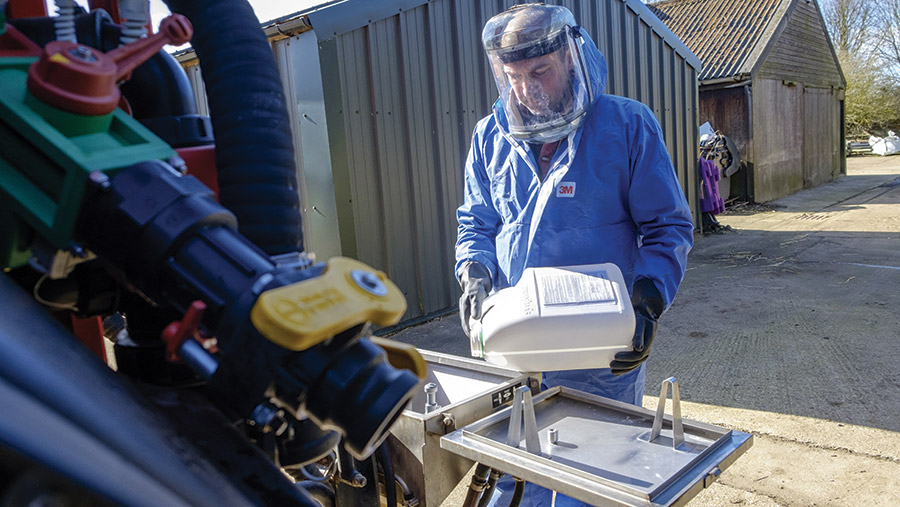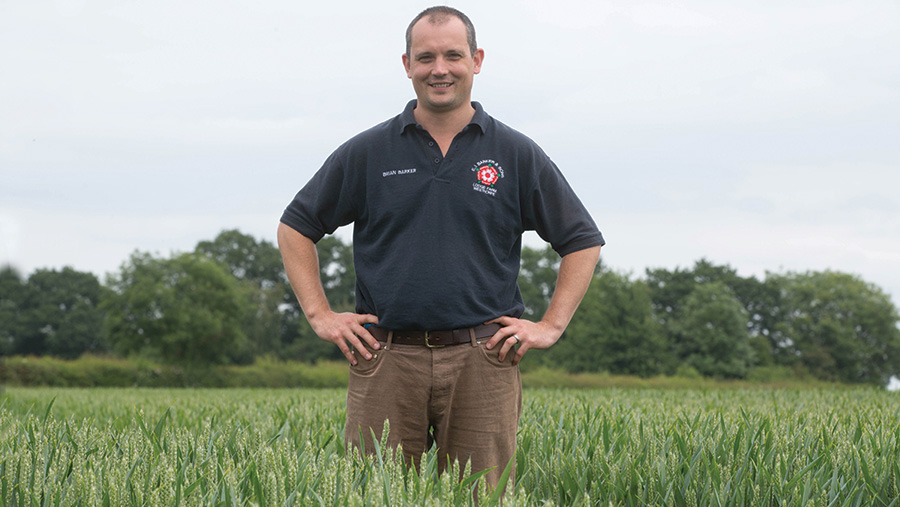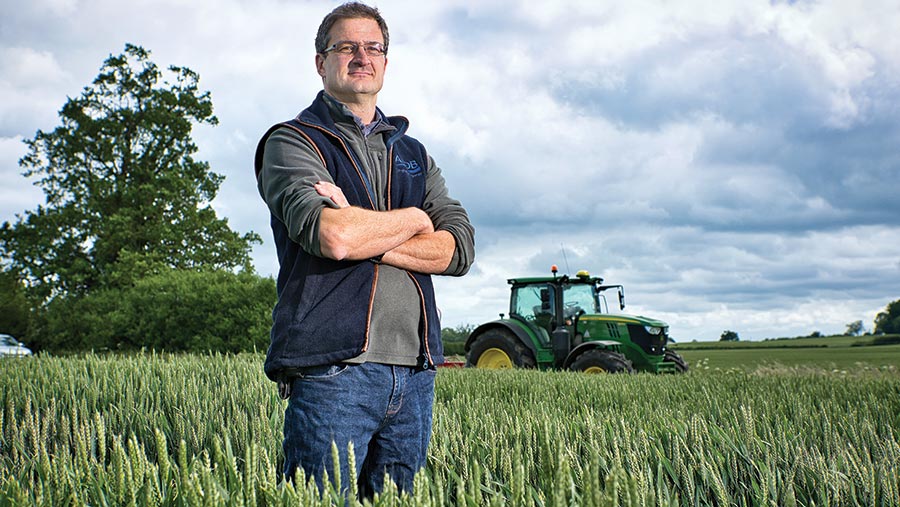How trials are helping two farmers maximise crop margins
 © Jason Bye
© Jason Bye Managing risk is the key objective for both AHDB’s two Strategic Cereals Farm hosts, as they look to use some of their on-farm trial lessons to manage crops affected by the extreme wet conditions.
With rain falling most days since the last week of September, Brian Barker, who farms near Stowmarket in Suffolk, considers himself lucky to have got his crops drilled in such a difficult autumn.
However, he is aware that their management from here will need to be very different to that in a drier year.
See also: How to keep on top of spring-germinating blackgrass
High seed rates, slug damage, lower biomass and poor rooting are on his mind, as he works out what he can apply to his commercial farming operation from two years of Strategic Farm trials.

Brian Barker © Tim Scrivener
“We’ve looked at starter fertilisers, which have shown differences in early crop architecture, but they haven’t translated into yield differences to date,” he says.
“However, it may be that the follow-on management of crops needs to be addressed where they have been used.
“All of our plots received the same nitrogen programme, rather than being based on their biomass.”
What are Strategic Farms?
Strategic cereal farms are platforms for testing and demonstrating new ways of working in a commercial setting, so that farmers can assess whether they could work on their businesses.
All the approaches tested are taken to yield and subject to full cost benefit analysis.
This year, given the later drilling dates and poorer soil conditions, placed starter fertilisers could give very different results, he suggests.
“Wheat going into cold, wet soils with a high slug presence needs all the help it can get.
“Poor rooting and low biomass are concerns right now.”
Maximise margins
Other work on using lower fungicide inputs showed the potential that more resistant varieties have to offer and has confirmed that not having a standard disease control approach is the right call.
“On this farm, we tend to have three or four different options, according to variety and potential.
“We also have to factor in the effects of the season,” says Mr Barker.
His 2019 trials looked at untreated, low-, medium- and high-input programmes on varieties with different levels of resistance, taking it through to net margin.
Although the highest yields came from a high-input regime costing £122/ha, the best net margin was produced from a low-input programme costing £31/ha on popular variety Graham.
“It was a low disease pressure year up until the T3 timing,” he recalls.
“Next year will be different again, which is why we have abandoned blanket treatments.
“Our aim is to maximise output, without huge costs and with no detriment to the environment.”
Importantly, there is less risk with resistant varieties, he notes, as they suffer less of a yield loss in a higher disease pressure year.
Otherwise, trials have confirmed the role of cover crops in taking up nitrogen and improving water quality, with lower nitrate concentrations being recorded in drainage water where they were grown.
The work will continue, confirms Mr Barker.
“Cover crops aren’t there to boost yield, but they are helping us to comply with legislation and improve soil health.
“Learning all we can about them now, before they become compulsory, is the right thing to do.”
Main messages: Strategic Farm East
- Starter fertiliser improves the initial establishment of late sown crops, but hasn’t shown consistent improvements in yield
- A well-established cover crop is effective at improving water quality
- Low fungicide inputs used on resistant varieties gave the best net margin in 2019
For Rob Fox in Warwickshire, having three times the farm’s average rainfall from mid-September to the end of November has scuppered his autumn planting plans, leaving him with 750ha of spring drilling to do and some important decisions to make.

Rob Fox © Richard Stanton
That makes first-year results from his cultivations depth trial very relevant, as the weather has a bearing on whether minimal cultivations can work on the heavy land farm.
Three cultivation depths have been tested – 5cm, 15cm and 30cm – so that he has a good comparison with his farm standard of 15cm.
Sustainable soils
Keen to manage his soils sustainably, Mr Fox would like to work shallower, but in a wet year, he finds that water sits in the top layer of soil and makes things very difficult.
“Last year was dry, so I could have got away with doing less,” he says.
“As we don’t know what sort of winter we will get, opting to scratch the surface and drill doesn’t let the water drain away if it turns wet.
“On the other hand, doing deeper cultivations than necessary can do more harm than good.”
He would like to know if there is a way to get rid of water with reduced cultivations and if cover crops could help with this.
“It’s been so wet that we’ve only managed to drill 20ha of winter wheat, rather than the planned 300ha, and our 100ha of oilseed rape is about to be written off.”
In the trials, there were no significant effects of cultivation depth on yield, even though greater rooting in the subsoil was measured following shallow 5cm cultivation.
“It was very dry last year. The results might be different in a wet year, as we know that more roots in the subsoil tends to increase above-ground biomass.”
His look at using less fungicide on the more resistant variety Graham showed that there was no yield loss from cutting back, with the low input regime costing £62/ha and the farm standard costing £80/ha.
Neither a T0 nor a T3 spray featured in the low-cost programme, but an unexpected appearance of yellow rust meant that he felt compelled to use an SDHI at T1 and T2.
“With hindsight, I could have been bolder,” he says.
“The overall saving was £45/ha, as there was no seed treatment used and the application costs were lower. It showed me that we weren’t compromising yield.”
Otherwise, soil health assessments have highlighted some soil structure and earthworm numbers issues on the farm – both of which were associated with the heaviest soils with below-average organic matter contents.
“We all know the problems of working soils when they’re wet, but it’s something that many farmers have been unable to avoid this autumn,” says Mr Fox.
“We will be looking at what interventions we can use successfully, which will involve understanding more about the physical, chemical and biological properties of our soils. It’s an on-going process here.”
Main messages: Strategic Farm West
- No yield loss from reducing fungicide inputs in 2019, but large differences observed between soil types
- Greater depth of rooting from shallow (5cm) cultivations, but no yield differences observed between three cultivation depths
- Soil health indicators must be monitored regularly for signs of problematic compaction at 10-20cm depth

